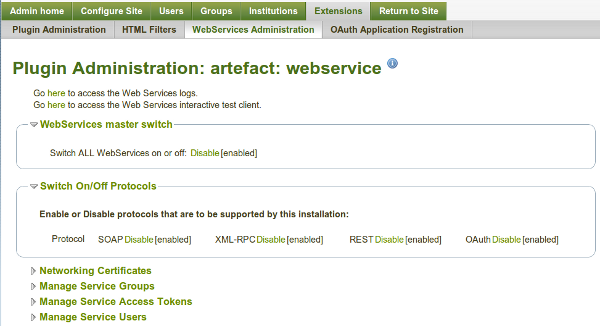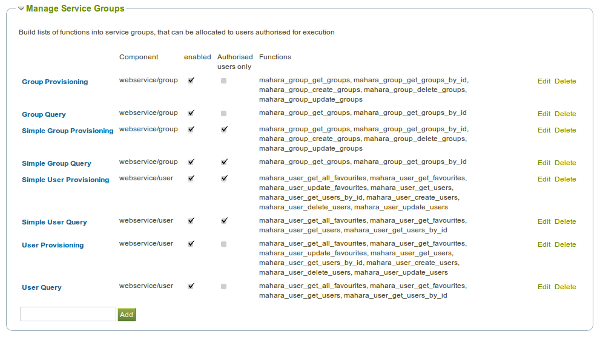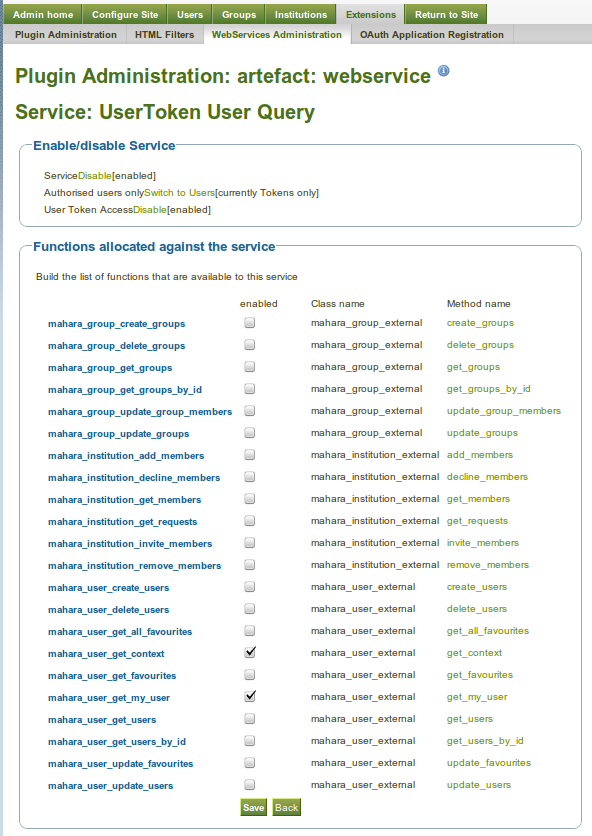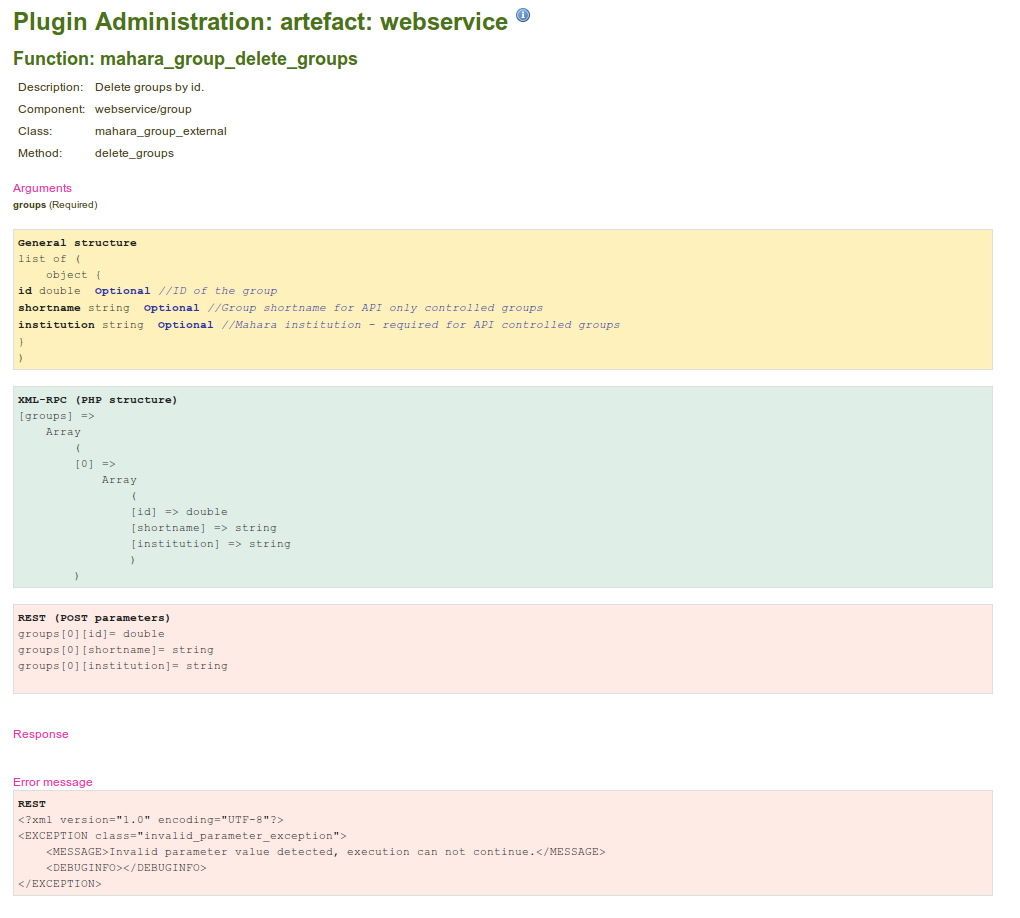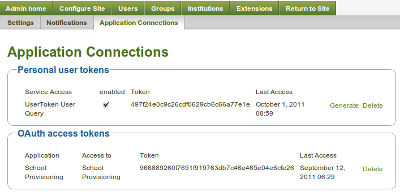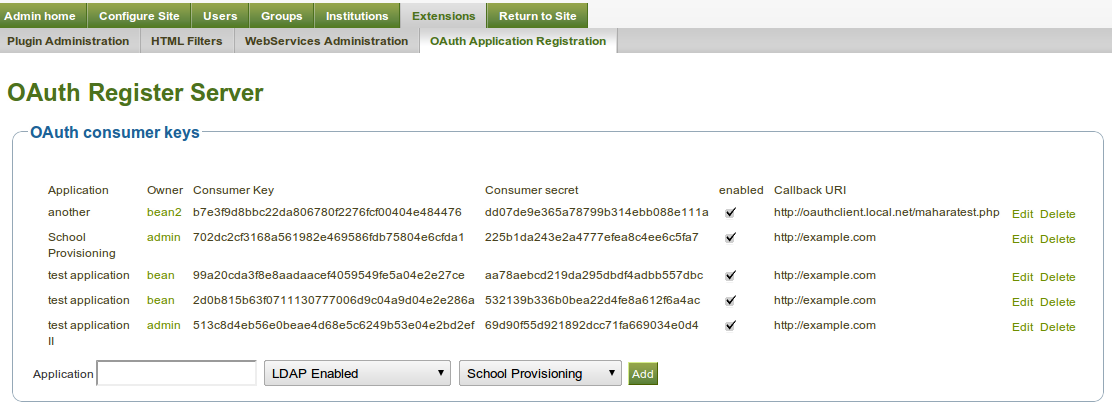Plugins/Artefact/WebServices/WebServicesConfiguration
From Mahara Wiki
< Plugins | Artefact | WebServices
Web Services Configuration
All Web Services configuration hangs off the plugin administration page http://your.mahara.local.net/artefact/webservice/pluginconfig.php
The main page:
From here, you can carry out all the main administrative tasks:
- Globally activate/deactivate web services
- activate/deactivate individual protocols (REST, SOAP, XML-RPC)
- Create Services Groups of Functions that can be accessed
- Generate access tokens, and allocate users, and services groups
- Grant access to users for simple authentication access, and allocate service groups
- look up API descriptions for functions
Global activation
Globally activate or deactivate all web service access for when you need to shut off access completely
Activating Protocols
Individual protocols can be activated or deactivated. Once activated, the protocol is available to all configured functions/users/tokens.
Available protocols are:
- SOAP
- REST (a basic HTTP and forms POST based interface)
- XML-RPC
- OAuth
Service Groups
Service groups are the unit of allocation of access to a user (simple auth) or user token. They are a collection of functions.
Give a service group a name, and then specify what functions are to be included. You must also decide what form of authentication can access this service group - web service token, or user simple auth (user and password).
From here, and individual service group can be deactivated for all users.
Function API Descriptions
From the Service Group editing view(above), there is a link to each API function that will take you to a description of the functions API - input/output parameters, and error handling.
Authentication
There are currently two forms of authentication for web service access, which are available for all protocols:
- Web Service Tokens
- User/Password based simple authentication
In both cases, the authentication data is passed as query string parameters:
- Token - http://your.mahara.local.net/artefact/webservice/rest/server.php?wstoken=484dfea8715ed427b4d95796c3013f7d
- simple auth - http://your.mahara.local.net/artefact/webservice/rest/simpleserver.php?wsusername=blah3&wspassword=blahblah
Note: that the application changes for each - server.php vs simpleserver.php
There is one exception, for SOAP, where the user and password can be passed as part of the Web Services Security Extension SOAP headers (wsse), as plaintext username and password. eg:
<env:Header> <wsse:Security env:mustUnderstand="1" xmlns:wsse="http://docs.oasis-open.org/wss/2004/01/oasis-200401-wss-wssecurity-secext-1.0.xsd"> <wsse:UsernameToken> <wsse:Username>bean</wsse:Username> <wsse:Password Type="http://docs.oasis-open.org/wss/2004/01/oasis-200401-wss-username-token-profile-1.0#PasswordText">blahblah</wsse:Password> </wsse:UsernameToken> </wsse:Security> </env:Header>
Token Based Access Control
Each token is generated, and allocated to a user. You then choose a service group that the given user is allowed to access with this token. Only service groups that have been enabled for tokens can be selected.
Personal User Token Based Access Control
Individual Users can have Personal Access Tokens. These are a specific type of access token that enables access to a Service Group that has been enabled for User Token Access. These appear in the same list under the users Settings page -> Application connections.
The purpose of these tokens, and the Service Groups restricted to 'User Token' is to provide individuals access to API calls that are restricted to their own data. For instance - a Service Group can be created 'User Token User Query' with the functions mahara_user_get_context, and mahara_user_get_my_user which enable a user to query their institution connection context (just the internal institution name), and their own user master details.
Simple User Authentication Access Control
To configure a user for simple authentication access, choose a user, and then allocate a service group. Only service groups that are enabled for simple user authentication can be used.
A selected user must have the "webservice" authentication method. This authentication method will only allow access via Web Services, restricting the user form normal login.
OAuth Authentication Access Control
OAuth service access is configured separately. This enables the selection of an institution and service definition, for which a consumer key, and secret will be automatically generated.
When an external application attempts to access the Mahara API via OAuth, it will be challenged requiring the user to login and accept the application linking. This creates a Mahara specific user access token. Mahara users can inspect and maintain their own access tokens:
